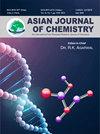印度古勒格拉姆 Badshahpur 湖重金属和细菌污染评估与缓解策略
Q4 Chemistry
引用次数: 0
摘要
本研究旨在评估印度古勒格拉姆市 Badshahpur 湖三个区域水样中的微生物负荷和重金属污染情况。共采集了 132 份水样:其中 47 份来自 1 区,40 份来自 2 区,45 份来自 3 区。微生物负荷以细菌总数(TBC)进行量化,重金属浓度,即镉(Cd)、铜(Cu)、铅(Pb)、铬(Cr)、砷(As)、汞(Hg)、锡(Sn)和甲基汞(MM),则使用 ICP-OES 进行测量。在 1 区,总生物量介于 5.2 × 103 至 3.7 × 109 CFU/mL 之间,其中 IEWS-A11 的微生物量最高。IEWS-A21 的镉含量较高,为 0.044 毫克/升,IEWS-A18 的铜浓度达到 0.091 毫克/升。此外,还检测到铅和铬,含量分别为 0.039 毫克/升和 0.031 毫克/升。2 区的总生物量为 4.0 × 104 至 6.7 × 108 CFU/mL,重金属浓度较高,尤其是铜为 0.088 mg/L,镉为 0.038 mg/L。3 区的 TBC 为 4.0 × 103 至 5.1 × 108 CFU/mL,其中 IEWS-C25 的镉浓度最高,为 0.046 mg/L,IEWS-C12 的铜浓度最高,为 0.086 mg/L。在检测的所有细菌中,大肠杆菌在所有区域都普遍存在,这表明粪便污染非常普遍。这些结果强调了重金属污染严重的地区,突出了持续监测水质、改进水处理方法和加强卫生基础设施对减少健康危害和保护环境稳定的重要性。本文章由计算机程序翻译,如有差异,请以英文原文为准。
Assessment and Mitigation Strategies for Heavy Metals and Bacterial Contamination in Badshahpur Lake, Gurugram, India
This study aims to assess the microbial load and heavy metals contamination in water samples from Badshahpur lake situated in Gurugram city, India across three zones. A total of 132 water samples were collected: 47 from zone 1, 40 from zone 2 and 45 from zone 3. The microbial load was quantified as total bacterial count (TBC) and concentrations of heavy metals viz. cadmium (Cd), copper (Cu), lead (Pb), chromium (Cr), arsenic (As), mercury (Hg), tin (Sn) and methyl mercury (MM) were measured using ICP-OES. In zone 1, TBC ranged from 5.2 × 103 to 3.7 × 109 CFU/mL, with the highest microbial load at IEWS-A11. Cadmium level was recorded higher at 0.044 mg/L at IEWS-A21 and copper concentrations reached 0.091 mg/L at IEWS-A18. Lead and chromium were also detected, with concerning levels of 0.039 mg/L and 0.031 mg/L, respectively. Zone 2 showed TBC from 4.0 × 104 to 6.7 × 108 CFU/mL, with significant heavy metal concentrations, particularly copper at 0.088 mg/L and cadmium at 0.038 mg/L. Zone 3 exhibited TBC ranging from 4.0 × 103 to 5.1 × 108 CFU/mL, with the highest cadmium concentration of 0.046 mg/L at IEWS-C25 and copper at 0.086 mg/L at IEWS-C12. Among all bacteria tested, the ubiquitous presence of E. coli across all zones indicates widespread faecal contamination. The results emphasize the areas with significant levels of heavy metal pollution, highlighting the importance of consistent monitoring of water quality, improved water treatment methods, and enhanced sanitation infrastructure to reduce health hazards and safeguard the stability of the environment.
求助全文
通过发布文献求助,成功后即可免费获取论文全文。
去求助
来源期刊

Asian Journal of Chemistry
化学-化学综合
CiteScore
0.80
自引率
0.00%
发文量
229
审稿时长
4 months
期刊介绍:
Information not localized
 求助内容:
求助内容: 应助结果提醒方式:
应助结果提醒方式:


